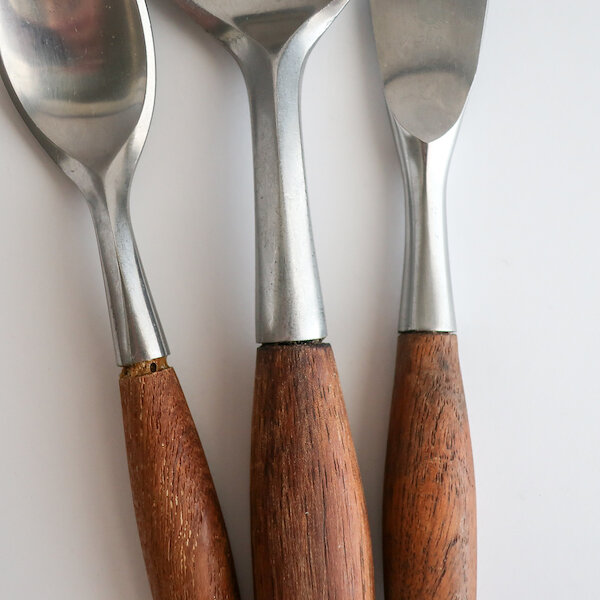Several years ago, I was lucky enough to acquire a large set of Dansk flatware in the Fjord pattern. It came through a client I had worked with on a big consignment while I was at Christie’s. When she asked what I was up to since I left the auction world, I told her I was buying and selling stuff, mostly mid-century modern and off-handedly mentioned Dansk. She said, ‘Oh, my mom has some of that stuff down in the basement. Would you like it?’ So I bought myself some Fjord flatware, along with a number of other Dansk pieces.
The basic five-piece place setting: teaspoon, tablespoon, dinner knife, dinner fork, and salad fork.
Fjord was the reason Dansk came into being. To briefly summarize: In 1953, Jens Quistgaard hand forged a set of stainless steel flatware with teak handles, a combination widely regarded as beautiful, but difficult to manufacture. Denmark’s Kunsthandwaerkmuseet quickly purchased the original set, where it was discovered by American businessman Ted Nierenberg and his wife, Martha. Nierenberg immediately sought out Quistgaard and convinced him that the flatware could be put into large-scale production. Thus began their partnership and Dansk was born.
Kongo and Fjord brochure with price list, circa 1955. Image courtesy of Rhonda Lester.
Reverse of the Kongo/Fjord brochure, showing a portrait of Jens Quistgaard. The ‘Good Design’ mark at the top right of the center section references the series of exhibitions of the same name held at The Museum of Modern Art in New York in the 1950s. Image courtesy of Rhonda Lester.
The flat edge around the bowl was one of the refinements of the Fjord pattern. This set was in exceptionally good condition, showing little to no wear to the stainless steel.
I think designing flatware is a funny thing--so much depends on minute measurements and there aren’t a whole lot of other objects that need to account for how they will feel in your mouth. Some flatware can look great, but when you use it, it’s just wrong. The handle doesn’t fit your hand quite right, the spoon is a weird shape in your mouth or the weight isn’t balanced. Quistgaard’s flatware does everything just right--the handles of Fjord are not perfectly round, but slightly ovoid which better fits your grip. The business ends of forks and spoons taper just enough and are not too broad or deeply bowled for comfort.
The earlier mark with the four ducks is on the spoon on the left and seems to date to the 1950s until maybe 1961 or so; the slightly later ‘Made in Germany’ mark seems to have run through the 1960s. Knives retained the four ducks for a longer period.
Early Dansk flatware was made in Germany, then production moved to Denmark, France and Finland, and later to Korea, Japan and China. General consensus among collectors seems to be that earlier European-made pieces are the more desirable.
Fjord serving pieces, from left to right: ladle, meat fork, serving spoons in the 9 and 11 inch sizes, 11-inch spork, and a butter spreader.
From what I can tell, the earliest boxes for Fjord were gray with silver foil labels and waxed paper to wrap the individual pieces.
Another early packaging variation was beige boxes with each piece wrapped in tissue paper.
Some items came in fitted black boxes, such as steak knives and bar sets.
In the 1960s, pieces were individually packaged in plastic. The iced teaspoons have the ‘Made in Germany’ mark with no duck, the butter spreaders have the four ducks.
Fjord on the dining table at Frank Lloyd Wright’s Fallingwater.
Another early Dansk pattern is ‘Fairwind’. It seems to have had a fairly short production period before 1960, and is similar to Fjord in the shape of the tines and bowls and the ridge line at the center. The overall shape is fairly conservative and reminiscent of 18th and 19th century flatware.
Dansk Fairwind stainless steel flatware.
‘Kongo’ is the other early pattern with the greatest similarity to Fjord. The stainless steel elements had the same shape, as did the handle, which was not wood, but black nylon, a type of plastic (not ebony, as it is sometimes misidentified). Like Fairwind, Kongo has a short life span and was apparently in production for a few years in the early 1960s—it appears in the 1960-61 advertising campaign, but by 1964 it seems to have been discontinued. I thought Kongo would be the sturdy plastic cousin of Fjord, that I could use it with no fear of damaging the wood handle, but the black nylon is actually very soft and easily scratched and dented.
Dansk catalogue, circa 1961, showing model numbers for each piece.
Kongo steak knives, with a smaller fruit knife below.
Kongo iced teaspoon and bottle opener. These were apparently unused and in the original box, but you can see the scratches in the soft nylon handle. I’ve seen these in mangled condition!
Condition Issues and How to Care for Fjord Flatware
Fjord requires a little bit more care than regular stainless steel flatware. The addition of a wood handle means that it cannot be put into the dishwasher and should not be left to soak in water. The wood will shrink and expand when exposed to heat and moisture, which destabilizes the join to the stainless steel and can cause cracking and splits along the grain. Teak is sturdy, but not indestructible!
As the original care card included with Fjord pieces indicates, on occasional rubdown with oil will help extend the life of the wood handle. Dansk recommended ‘salad or vegetable oil’, and I have certainly used these in a pinch, but I like to use a more stable, food-safe oil such as linseed or mineral oil. Vegetable oils can go rancid and spoil—this isn’t so much of an issue on flatware that gets handled regularly, but if you’ve ever had a teak salad bowl that hasn’t been cleaned properly, you know that the oil on the wood surface can get smelly and sticky. I prefer to avoid that! I put some oil on a paper towel or cotton cloth, rub it into the wood, then wipe off the excess. The oil sinks in after a few minutes. How often I oil depends on how much the flatware is used (remember, water is the bigger danger) and the temperature and humidity level of the environment (if you live in the desert, oil more often!).
Serious damage to the wood handle, revealing the construction within. The metal tang is surrounded by a soft gray metal (pewter?).
Typical condition issues found in Fjord flatware are: wear, scratches, rust, and pitting to the stainless steel; splits and losses to the teak; separation between the stainless and wood; wear and corrosion to the plug at the end of the wood handle. Generally, as long at the piece is stable, none of these will impede the use of the flatware and some people don’t care about any of this (and buying sets in less-than-perfect condition is a good way to save a few dollars). I’m super picky about condition and prefer sets that show very little use.
Separations between the stainless steel and wood. Sometimes the result is a loose handle, but usually the join remains pretty tight. You will also see some darkening around the join, even in pieces that have seen little use.
Cracks along the grain of the teak, at the center join and at the plug end. Sometimes the dark open grain of the wood will look like it might be a crack, but a real split will generally vary in width and not necessarily follow the line of the grain, as in the center piece.
Issues with the plugs, from the left: Protruding plug, missing plugs, and plugs with wear and corrosion. The three on the right are worn around the perimeter, but you’ll also see a sort of white ring of build up. Not sure what this is, maybe some sort of calcification?
This is what untouched plugs look like, from a set that was never used. The gray material on the face is very soft and easily scratched.
I am always looking to purchase sets of Fjord, Fairwind, Tjorn, Odin, and other early Dansk patterns (generally, German or Finnish production) in good condition. Contact me if you would like to discuss your set—I’ll need to know how many pieces you have, the marks (which should tell where it was made), and overall condition, along with a few images.
If you are interested in buying Fjord or other Dansk pieces, you can check my shop here, or be in touch with me—I often have individual pieces, place settings or serving pieces that are not listed.
© All text and images are copyright of Jeni Sandberg






















